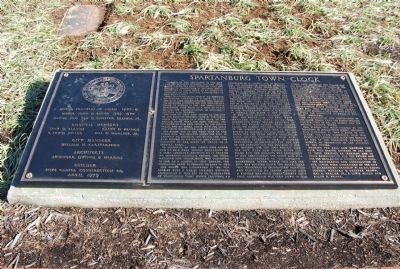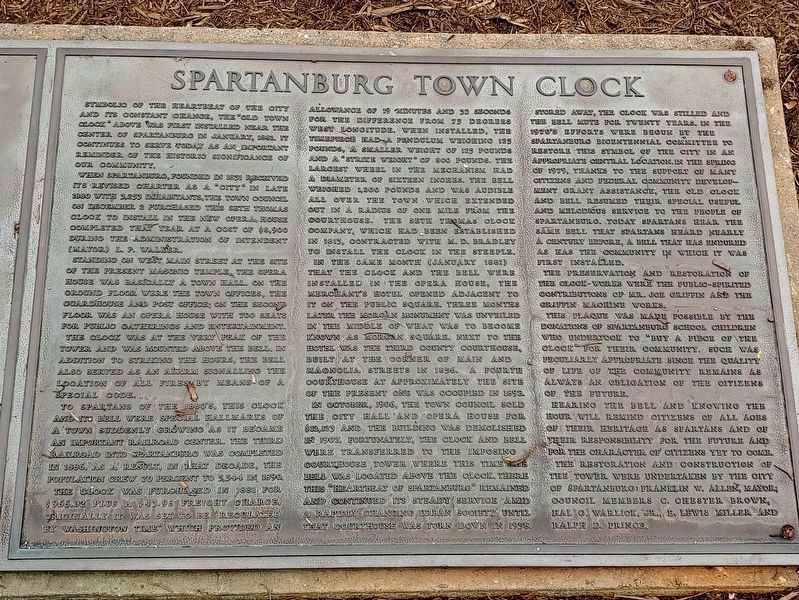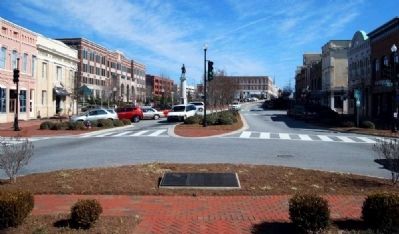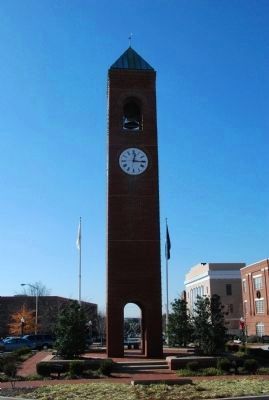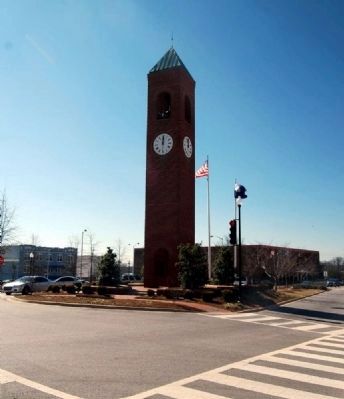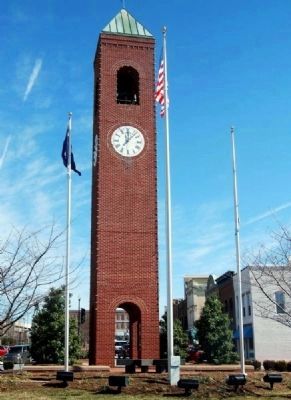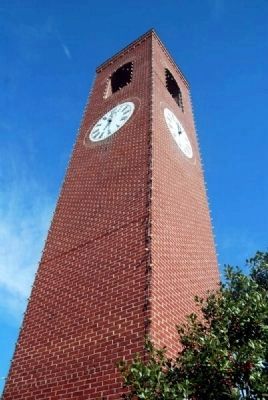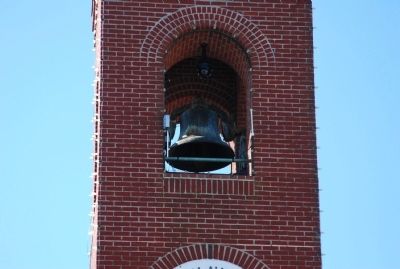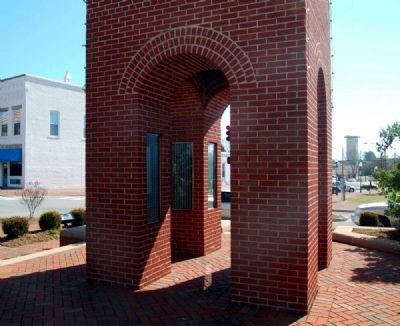Spartanburg in Spartanburg County, South Carolina — The American South (South Atlantic)
Spartanburg Town Clock
Mayor Frankin W. Allen 1977-81
Mayor John G. Baeher 1973-1977
Mayor Pro Tem C. Chester Brown, Jr.
Council Members
Jack M. Blasius, Ralph D. Prince
E. Lewis Miller, Hal G. Warlick, Jr.
City Manager
William H. Carstarphen
Architects
Skidemore, Owings & Merrill
Builder
Fiske Carter Construction Co.
April 1979
Symbolic of the heartbeat of the city and its constant change, the "Old Town Clock" above was first installed near the center of Spartanburg in January, 1881. It continues to serve today as an important reminder of the historic significance of our community.
When Spartanburg, founded in 1831 received its revised charter as a "city" in late 1880 with 3,253 inhabitants, the town council on December 2 purchased this Seth Thomas clock to install in the new opera house completed that year at a cost of $8,900 during the administration of intendent (mayor) L.P. Walker.
Standing on West Main Street at the site of the present masonic temple, the opera house was basically a town hall, on the ground floor were the town offices, the guardhouse and post office; on the second floor was an opera house with 700 seats for public gatherings and entertainment. The clock was at the very peak of the tower and was mounted above the bell. In addition to striking the hours, the bell also served as an alarm signalling the location of all fires by means of a special code.
To Spartans of the 1880's, this clock and its bell were special hallmarks of a town suddenly growing as it became an important railroad center. The third railroad into Spartanburg was completed in 1886. As a result, in that decade, the population grew 70 percent to 5,554 in 1890.
The clock was purchased in 1881 for $966.02 plus a $43.98 freight charge. Originally it was set to be "regulated by Washington Time" which provided an allowance of 19 minutes and 32 seconds for the difference from 75 degrees west longitude. When installed, the timepiece had a pendulum weighing 125 pounds, a smaller weight of 125 pounds and a "strike weight" of 800 pounds. The largest wheel in the mechanism had a diameter of sixteen inches. The bell weighed 1,200 pounds and was audible all over the town which extended out in a radius of one mile from the courthouse. The Seth Thomas Clock Company, which had been established in 1813, contracted with M.D. Bradley to install the clock in the steeple.
In the same month (January 1881) that the clock and the bell were installed in the opera house, the merchant's hotel opened adjacent to it on the public square. Three months later the Morgan Monument was unveiled in the middle of what was to become known as Morgan Square. Next to the hotel was the third county courthouse, built at the corner of Main and Magnolia Streets in 1856. A fourth courthouse at approximately the site of the present one was occupied in 1892.
In October, 1906, the town council sold the city hall and opera house for $12,123 and the building was demolished in 1907. Fortunately, the clock and bell were transferred to the imposing courthouse tower where this time the bell was located above the clock. There this "Heartbeat of Spartanburg" remained and continued its steady service amid a rapidly changing urban society until that courthouse was torn down in 1958.
Stored away, the clock was stilled and the bell mute for twenty years. In the 1970's efforts were begun by the Spartanburg Bicenntennial Committee to restore this symbol of the city in an appropriate central location. In the spring of 1979, thanks to the support of many citizens and federal community development grant assistance, the old clock and bell resumed their special, useful, and melodious service to the people of Spartanburg. Today Spartans hear the same bell that Spartans heard nearly a century before, a bell that has endured as has the community in which it was first installed.
The preservation and restoration of the clock-works
were the public-spirited contributions of Mr.Joe Griffin and the Griffin Machine Works.
This plaque was made possible by the donations of Spartanburg school children who undertook to "buy a piece of the clock" for their community. Such was peculiarly appropriate since the quality of life of the community remains as always an obligation of the citizens of the future.
Hearing the bell and knowing the hour will remind citizens of all ages of their heritage as Spartans and of their responsibility for the future and for the character of citizens yet to come.
The restoration and construction of the tower were undertaken by the city of Spartanburg: Franklin W. Allen, Mayor; Council members C. Chester Brown, Hal G. Warlick, Jr., E. Lewis Miller and Ralph D. Prince.
Erected 1979.
Topics. This historical marker is listed in these topic lists: Landmarks • Notable Places. A significant historical month for this entry is January 1881.
Location. 34° 56.94′ N, 81° 56.022′ W. Marker is in Spartanburg, South Carolina, in Spartanburg County. Marker is at the intersection of West Main Street and Spring Street, on the left when traveling east on West Main Street. Touch for map. Marker is in this post office area: Spartanburg SC 29306, United States of America. Touch for directions.
Other nearby markers. At least 10 other markers are within walking distance of this marker. Spartanburg Water Works (a few steps from this marker); 156 West Main Street (within shouting distance of this marker); William Walker / Clara Smith (within shouting distance of this marker); Daniel Morgan Monument (within shouting distance of this marker); Cantrell Wagon Building (about 300 feet away, measured in a direct line); Chaser the Border Collie (about 300 feet away); Arthur Prysock / Ira Tucker (about 300 feet away); Dr. Rosa H. Gantt (about 600 feet away); Pink Anderson / The Marshall Tucker Band (about 600 feet away); Palmetto Building (about 800 feet away). Touch for a list and map of all markers in Spartanburg.
More about this marker. The marker is set into the ground in front of the clock tower.
Also see . . .
1. Spartanburg, South Carolina. Spartanburg is the largest city in and the county seat of Spartanburg County, South Carolina, United States. (Submitted on February 16, 2011, by Brian Scott of Anderson, South Carolina.)
2. City of Spartanburg. Official website of the City of Spartanburg. (Submitted on February 16, 2011, by Brian Scott of Anderson, South Carolina.)
3. Spartanburg Historic District. The Spartanburg Historic District contains a concentration of late-nineteenth and early-twentieth commercial architecture in and around Morgan Square in the commercial district of Spartanburg. (Submitted on February 17, 2011, by Brian Scott of Anderson, South Carolina.)
Additional commentary.
1. About The Clock Tower
In 1976 former Mayor Robert L. Stoddard (1962-1973) who was serving as the Chairman of the Spartanburg County Bi- Centennial Commission, approached City Council with the idea of erecting the clock Tower and restoring the clock. At the time the clock was sitting in storage at City Hall-having not been displayed since the destruction of the Courthouse in 1958. It was part of his suggestion to Council to have students of the public schools donate money to build the tower to house the clock. This was approved by City Council.
The project spearheaded by former Mayor Stoddard was a huge success. He thought that this would be a good history lesson for the students. Those who donated have their names displayed within the tower. Mayor Stoddard presided at the ribbon cutting in 1979 when the project was completed. He wore a replica of a Revolutionary War era outfit. It has been a landmark for the City of Spartanburg since that date.
— Submitted March 9, 2023, by Wesley A Stoddard of Spartanburg, South Carolina.
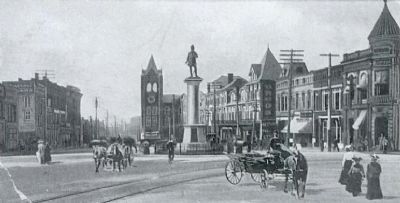
Spartanburg, South Carolina by Jeffrey R. Willis, circa 1900
10. Square Showing Morgan Monument and Opera House Tower
The building with the clock tower is the Opera House, designed by Gofdrey Norman and built in 1880. Spartanburg's bity hall occupied the first floor. On the second floor there was an auditorium. The building was town down about 1907 and the property sold to the Masons, who build the present Masonic Temple on it in 1928.
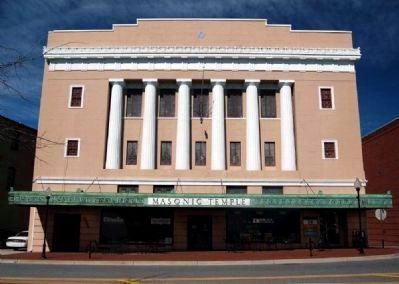
Photographed By Brian Scott, February 14, 2011
11. Masonic Temple -
188 West Main Street
Location of Spartanburg Opera House
188 West Main Street
Location of Spartanburg Opera House
Spartanburg's Masonic Temple was constructed in 1927 and reflects the Neo-Classical style of the early 20th century. It is a three-story brick building faced with stone veneer. The first story is five bays wide with three recessed entryways and two large rectangular windows. The first story facade has a rusticated finish. A large metal canopy decorated with a Greek fret band spans the facade. The upper stories feature rectangular windows and a recessed colonnade of engaged Doric columns. Above the third story s an entablature with triglyphs and metopes. The building is topped with a stepped parapet. Interior features include a large meeting hall and offices. (Source: Spartanburg Historic District National Register nomination form.)
Credits. This page was last revised on March 24, 2024. It was originally submitted on December 21, 2009, by Michael Sean Nix of Spartanburg, South Carolina. This page has been viewed 2,422 times since then and 177 times this year. Photos: 1. submitted on December 21, 2009, by Michael Sean Nix of Spartanburg, South Carolina. 2. submitted on March 22, 2024, by Mark Parker of Hickory, North Carolina. 3. submitted on February 16, 2011, by Brian Scott of Anderson, South Carolina. 4. submitted on December 21, 2009, by Michael Sean Nix of Spartanburg, South Carolina. 5, 6, 7. submitted on February 16, 2011, by Brian Scott of Anderson, South Carolina. 8. submitted on December 21, 2009, by Michael Sean Nix of Spartanburg, South Carolina. 9, 10, 11. submitted on February 16, 2011, by Brian Scott of Anderson, South Carolina. • Bill Pfingsten was the editor who published this page.
